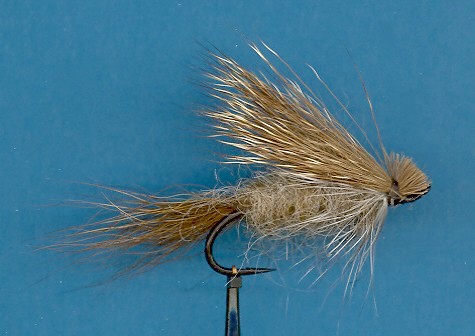
On The Fly
"Fly tying is a school from which we never graduate"
TYING NEWSThe Southern Oregon Fly Tiers met Thursday, August 25th at the library in Gold Hill. There was a fly raffle and fly exchange along with demonstrations. Join us the fourth Thursday of each month for more fun and the sharing of the art.
Attention all tiers!! The steelhead tournament and auction are coming up soon. How about tying up a dozen of your favorite steelhead pattern and donating them to a very worthy cause? It's the best way for us to support our own club. For donation forms or to drop off your flies, contact Johnny Hale or myself by phone or see us at a meeting.
 PATTERN OF THE MONTH - Grease Liner by Harry Lemire
PATTERN OF THE MONTH - Grease Liner by Harry Lemire
Hook Steelhead, light wire, up eye, sizes 4 - 6.
Thread Black, 6/0.
Tail Dark deer hair, full.
Body Dark grayish tan to black fur dubbing.
Throat Sparse grizzly hackle.
Wing Dark deer hair extending to the end of the body with the butts shaped as shown.
Tying Instructions:
1) Start the thread at a position on the hook shank that allows the proper room for the head.
Use this as a marker and don't tie anything past this mark. Wrap a thread base back to a position just
above the hook point.
2) Tie in a fairly good-sized bunch of deer hair, one shank length. I leave the hair unstacked for a more
natural look.
3) Form a dubbing loop, apply the dubbing, twist the dubbing and wind it forward leaving enough space for
the head.
4) Tie in some grizzly hackle barbs throat style.
5) Tie in a good-sized bunch of deer hair for the wing using the Wing Bundle Technique (see Tying Tips).
Tie the wing in very tightly to achieve tight compression of the hair.
6) Clip the wing to shape as shown. Whip finish under the wing hair butts to kick them up a bit. Cement the
thread wraps letting some extra cement wick into the wing to hold its shape.
The Grease Liner is perhaps one of the best flies for summer steelhead around. Created in 1962 on the Wenatchee River by a pioneer of the Northwest's steelhead fly fishers, Harry Lemire of Black Diamond, Washington. Lemire is the country's only known master fly-tier who does it the "renaissance-era" way by creating Atlantic Salmon flies without a vise. Those of us that have seen him in action at the Fly Tying Expo in Eugene, Oregon, have witnessed an old art form and the man who keeps the history alive.
Tied on a light wire hook, the Grease Liner uses a typical wet fly throat hackle and relies on the bushy deer hair tail and wing for floatation and a shaped deer hair head that assists in skating. The pattern is simple to tie and one that has accounted for many fish over the years. This pattern can also be tied in other colors and materials. With an orange body it can be extremely effective when the October Caddis is in the air. You can substitute moose body hair for the deer or sub peacock herl for the body dubbing.
The Grease Liner can be fished "Dry," however, when fished downstream (under tension from the line and current) it has proven to be more productive under most conditions. Harry's "Greased Line" method incorporates a "damp fly" riding in the surface film. Often it is cast upstream and led across the current under light tension, downstream from the angler;A "riffle hitch" is often used to change the fly/leader connection so that the fly pulls at an angle to the current. This way the fly will always seek the path of least resistance, which is the surface.
In his own words Harry Lemire describes his Grease Liner as "a waking fly of unquestionable merit" Tie some up, give them a good test flight, and I'm sure you will agree with him.
TYING TIPS - Thread Ribs
When you tie on any hair wing the biggest challenge is to keep the wing on top of
the hook, not rolling around the far side. One easy method is called the Wing Bundle Technique. The idea is
to wrap the hair into a bundle before fastening it onto the hook. Here's the trick. Hold the bunch of hair
slightly above the shank and take a loose wrap around just the hair, then a second wrap around the hook.
Continue to hold the hair tightly in your left hand while pulling up on the thread, compressing the hair.
Now take a third wrap and compress the hair further. Each wrap should be side by side for maximum tightness.
Then take the same number of wraps back to just short of the first wrap to lock in place. Give it a try.
Tie One On,
Dan Kellogg
(you can contact me at FLYGUY@EZNORTHWEST.COM)